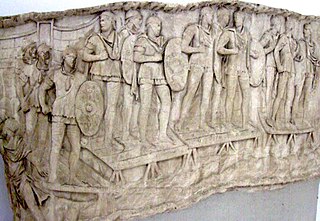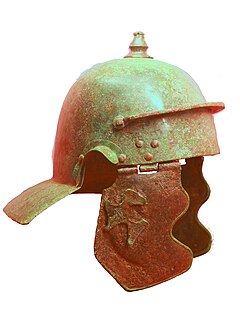| Cohors VII Delmatarum equitata | |
|---|---|
 Roman infantry helmet (late 1st century) | |
| Active | 1st century |
| Country | Roman Empire |
| Type | Roman auxiliary cohort |
| Role | infantry/cavalry |
| Size | 600 men (480 infantry, 120 cavalry) |
| Garrison/HQ | Mauretania Caesariensis 1st century |
Cohors septima Delmatarum equitata ("7th part-mounted Cohort of Dalmatae") was a Roman auxiliary mixed infantry and cavalry regiment. It is named after the Dalmatae, an Illyrian-speaking tribe that inhabited the Adriatic coastal mountain range of the eponymous Dalmatia. The ancient geographer Strabo describes these mountains as extremely rugged, and the Dalmatae as backward and warlike. He claims that they did not use money long after their neighbours adopted it and that they "made war on the Romans for a long time". He also criticises the Dalmatae, a nation of pastoralists, for turning fertile plains into sheep pasture. [1] Indeed, the name of the tribe itself is believed to mean "shepherds", derived from the Illyrian word delme ("sheep"). [2] The final time this people fought against Rome was in the Illyrian revolt of 6-9 AD. The revolt was started by Dalmatae auxiliary forces and soon spread all over Dalmatia and Pannonia. The resulting war was described by the Roman writer Suetonius as the most difficult faced by Rome since the Punic Wars two centuries earlier. But after the war, the Dalmatae became a loyal and important source of recruits for the Roman army.

The Dalmatae or Delmatae were an ancient people who inhabited the core of what would then become known as Dalmatia after the Roman conquest at the eastern Adriatic coast, in what is present-day Croatia and Bosnia and Herzegovina, between the rivers Krka, on the northwest, the Neretva on the east, and the river Rama on the northeast. The Delmatae are mostly classed as an Illyrian tribe.

Dalmatia is one of the four historical regions of Croatia, alongside Croatia proper, Slavonia, and Istria.

Strabo was a Greek geographer, philosopher, and historian who lived in Asia Minor during the transitional period of the Roman Republic into the Roman Empire.
Contents
According to Holder, a total of 12 cohortes Delmatarum appear to have been raised after the suppression of the Illyrian revolt in two series, of 7 and 5 respectively. All these units were in existence by the time of emperor Claudius (r. 41-54) [3] Of these, 9 appear to have survived into the 2nd century. [4]

Claudius was Roman emperor from AD 41 to 54. A member of the Julio-Claudian dynasty, he was the son of Drusus and Antonia Minor. He was born at Lugdunum in Gaul, the first Roman Emperor to be born outside Italy. Because he was afflicted with a limp and slight deafness due to sickness at a young age, his family ostracized him and excluded him from public office until his consulship, shared with his nephew Caligula in 37.
The regiment was probably raised by founder-emperor Augustus (r. 30BC-14AD) after 9 AD. It was certainly in existence by the time of Claudius (r. 41-54). [3] There is no diploma evidence for this regiment and the remaining inscriptions cannot be accurately dated. However, it is certain that it was serving in Mauretania Caesariensis in the 1st century. It is unlikely to have continued there into the 2nd century, as it is missing in the diploma list for 107. All its surviving inscriptions have been found on one site, Cherchel (Algeria), presumably its regular base, perhaps shared with its sister regiment VI Delmatarum eq. [5] Given the complete absence of later evidence, it is likely that the regiment was disbanded or destroyed in action by the end of the 1st century.

Augustus was a Roman statesman and military leader who was the first emperor of the Roman Empire, reigning from 27 BC until his death in AD 14. His status as the founder of the Roman Principate has consolidated an enduring legacy as one of the most effective and controversial leaders in human history. The reign of Augustus initiated an era of relative peace known as the Pax Romana. The Roman world was largely free from large-scale conflict for more than two centuries, despite continuous wars of imperial expansion on the Empire's frontiers and the year-long civil war known as the "Year of the Four Emperors" over the imperial succession.
A Roman military diploma was a document inscribed in bronze certifying that the holder was honourably discharged from the Roman armed forces and/or had received the grant of Roman citizenship from the emperor as reward for service.

Mauretania Caesariensis was a Roman province located in what is now Algeria in the Maghreb. The full name refers to its capital Caesarea Mauretaniae, in order to distinguish it from neighboring Mauretania Tingitana, which was ruled from Tingis.
The names of one decurio (cavalry officer) and 2 caligati (common soldiers) are attested, the latter Illyrians. [5]
Decurio was an official title in Ancient Rome, used in various connections:
- A member of the senatorial order in the Italian towns under the administration of Rome, and later in provincial towns organized on the Italian model. The number of decuriones varied in different towns, but was usually 100. The qualifications for the office were fixed in each town by a special law for that community. Cicero alludes to an age limit, to a property qualification, and to certain conditions of rank. The method of appointment varied in different towns and at different periods. In the early municipal constitution ex-magistrates passed automatically into the senate of their town; but at a later date this order was reversed, and membership of the senate became a qualification for the magistracy. Cicero speaks of the senate in the Sicilian towns as appointed by a vote of the township. But in most towns it was the duty of the chief magistrate to draw up a list (album) of the senators every five years. The decuriones held office for life. They were convened by the magistrate, who presided as in the Roman Senate. Their powers were extensive. In all matters the magistrates were obliged to act according to their direction, and in some towns they heard cases of appeal against judicial sentences passed by the magistrate. By the time of the municipal law of Julius Caesar special privileges were conferred on the decuriones, including the right to appeal to Rome for trial in criminal cases. Under the principate their status underwent a marked decline. The office was no longer coveted, and documents of the 3rd and 4th centuries show that means were devised to compel members of the towns to undertake it. By the time of the jurists it had become hereditary and compulsory. This change was largely due to the heavy financial burdens which the Roman government laid on the municipal senates.
- The leader of a decuria, a subdivision of the curia.
- An officer in the Roman cavalry, originally commanding a troop of ten men (decuria) during the early republican era. In the late republic and during the empire a decurio commanded a turma of 32 men in the auxiliary cavalry. It is the equivalent of the ancient Greek dekarchos, a cavalry officer.
- Decurio was also a name given to certain priests intended, as it should seem, for some particular sacrifices, or other religious ceremonies; or for the sacrifices of private families and houses, as Burkhard Gotthelf Struve (1671-1738) conjectures, who from that source derives their name. Whatever the origin of the name, we have an inscription in Gruter's work, which confirms their function: ANCHIALVS. CVB. AED. Q. TER. IN. AEDE. DECVRIO. ADLECTVS. EX. CONSENSV. DECVRIONVM. FAMILIAE. VOLVNTATE., which describes a decurio in the house of a private person, Q. Terentius.



